child seat HONDA FIT 2016 3.G Quick Guide
[x] Cancel search | Manufacturer: HONDA, Model Year: 2016, Model line: FIT, Model: HONDA FIT 2016 3.GPages: 75, PDF Size: 5.39 MB
Page 3 of 75
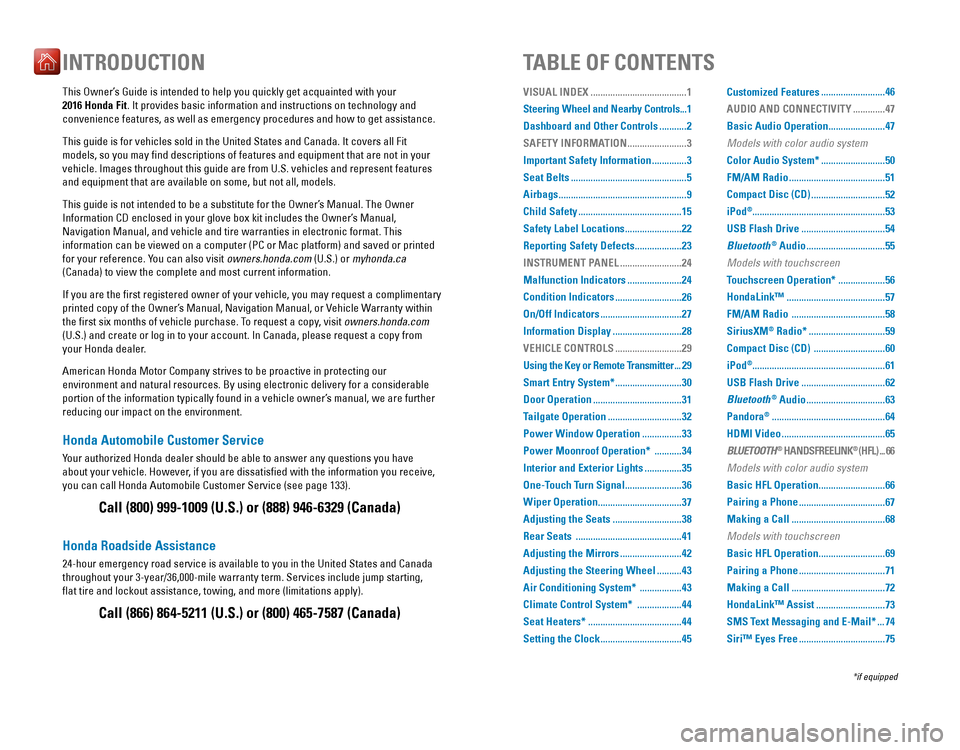
Honda Automobile Customer Service
Your authorized Honda dealer should be able to answer any questions you have
about your vehicle. However, if you are dissatisied with the information you receive, you can call Honda Automobile Customer Service (see page 133).
Honda Roadside Assistance
24-hour emergency road service is available to you in the United States and Canada
throughout your 3-year/36,000-mile warranty term. Services include jump starting, �at tire and lockout assistance, towing, and more (limitations apply).
This Owner’s Guide is intended to help you quickly get acquainted with your 2016 Honda Fit
. It provides basic information and instructions on technology and
convenience features, as well as emergency procedures and how to get assistance. This guide is for vehicles sold in the United States and Canada. It covers all Fit models, so you may ind descriptions of features and equipment that are not in your vehicle. Images throughout this guide are from U.S. vehicles and represent features and equipment that are available on some, but not all, models.
This guide is not intended to be a substitute for the Owner’s Manual. The Owner
Information CD enclosed in your glove box kit includes the Owner’s Manual, Navigation Manual, and vehicle and tire warranties in electronic format. This information can be viewed on a computer (PC or Mac platform) and saved or printed
for your reference. You can also visit owners.honda.com (U.S.) or myhonda.ca
(Canada) to view the complete and most current information.
If you are the irst registered owner of your vehicle, you may request a complimentary
printed copy of the Owner’s Manual, Navigation Manual, or Vehicle Warranty within
the irst six months of vehicle purchase. To request a copy, visit owners.honda.com
(U.S.) and create or log in to your account. In Canada, please request a copy from
your Honda dealer. American Honda Motor Company strives to be proactive in protecting our
environment and natural resources. By using electronic delivery for a considerable
portion of the information typically found in a vehicle owner’s manual, we are further reducing our impact on the environment.
INTRODUCTION TABLE OF CONTENTS
Call (800) 999-1009 (U.S.) or (888) 946-6329 (Canada) Call (866) 864-5211 (U.S.) or (800) 465-7587 (Canada)
VISUAL INDEX ....................................... 1
Steering Wheel and Nearby Controls ...1
Dashboard and Other Controls ...........2
SAFETY INFORMATION
........................3
Important Safety Information
..............3
Seat Belts ............................................... 5
Airbags .................................................... 9
Child Safety .......................................... 15
Safety Label Locations .......................22
Reporting Safety Defects ...................23
INSTRUMENT PANEL
.........................24
Malfunction Indicators
......................24
Condition Indicators ...........................26
On/Off Indicators ................................. 27
Information Display ............................28
VEHICLE CONTROLS
...........................29
Using the Key or Remote Transmitter
...29
Smart Entry System* ...........................30
Door Operation .................................... 31
Tailgate Operation ..............................32
Power Window Operation ................33
Power Moonroof Operation* ...........34
Interior and Exterior Lights ...............35
One-Touch Turn Signal .......................36
Wiper Operation .................................. 37
Adjusting the Seats ............................38
Rear Seats ........................................... 41
Adjusting the Mirrors .........................42
Adjusting the Steering Wheel ..........43
Air Conditioning System* .................43
Climate Control System* ..................44
Seat Heaters* ...................................... 44
Setting the Clock ................................. 45Customized Features
..........................
46
AUDIO AND CONNECTIVITY
.............47
Basic Audio Operation
.......................47
Models with color audio system
Color Audio System* ..........................50
FM/AM Radio ....................................... 51
Compact Disc (CD) ..............................52
iPod ®
......................................................53
USB Flash Drive .................................. 54
Bluetooth ®
Audio ................................ 55
Models with touchscreen
Touchscreen Operation* ...................56
HondaLink™ ........................................ 57
FM/AM Radio ...................................... 58
SiriusXM ®
Radio* ............................... 59
Compact Disc (CD) .............................60
iPod ®
......................................................61
USB Flash Drive .................................. 62
Bluetooth ®
Audio ................................ 63
Pandora ®
.............................................. 64
HDMI Video .......................................... 65
BLUETOOTH®
HANDSFREELINK ®
(HFL) ...66
Models with color audio system
Basic HFL Operation ...........................66
Pairing a Phone ................................... 67
Making a Call ...................................... 68
Models with touchscreen
Basic HFL Operation ...........................69
Pairing a Phone ................................... 71
Making a Call ...................................... 72
HondaLink™ Assist ............................73
SMS Text Messaging and E-Mail* ...74
Siri™ Eyes Free ................................... 75
*if equipped
Page 5 of 75
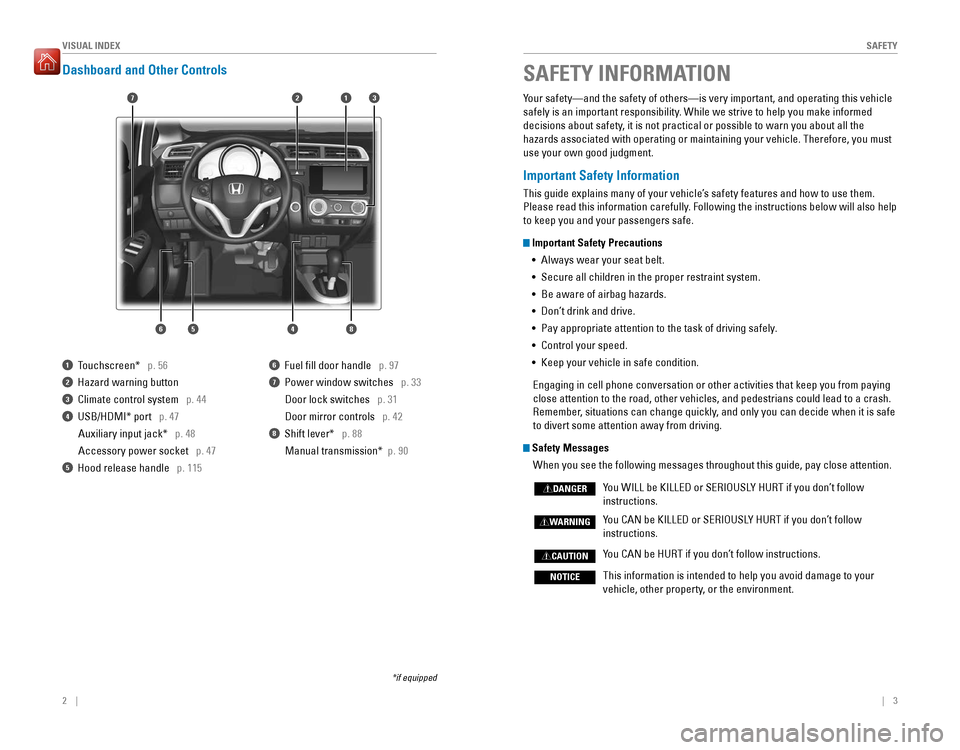
2 || 3
S
AFETY
VISUAL INDEX
Dashboard and Other Controls
1 Touchscreen* p. 56
2 Hazard warning button
3 Climate control system p. 44
4 USB/HDMI* port p. 47
Auxiliary input jack* p. 48
Accessory power socket p. 47
5 Hood release handle p. 115
6 Fuel �ll door handle p. 97
7 Power window switches p. 33
Door lock switches p. 31
Door mirror controls p. 42
8 Shift lever* p. 88
Manual transmission* p. 90
*if equipped Your safety—and the safety of others—is very important, and operating this vehicle
safely is an important responsibility. While we strive to help you make informed
decisions about safety, it is not practical or possible to warn you about all the hazards associated with operating or maintaining your vehicle. Therefore, you must use your own good judgment.
Important Safety Information
This guide explains many of your vehicle’s safety features and how to use them.
Please read this information carefully. Following the instructions below will also help to keep you and your passengers safe.
Important Safety Precautions
•
Always wear your seat belt.
• Secure all children in the proper restraint system.
• Be aware of airbag hazards.
• Don’t drink and drive. • Pay appropriate attention to the task of driving safely.
• Control your speed.
• Keep your vehicle in safe condition.
Engaging in cell phone conversation or other activities that keep you from paying close attention to the road, other vehicles, and pedestrians could lead to a crash.
Remember, situations can change quickly, and only you can decide when it is safe to divert some attention away from driving.
Safety Messages
When you see the following messages throughout this guide, pay close attention.
You WILL be KILLED or SERIOUSLY HURT if you don’t follow
instructions. You CAN be KILLED or SERIOUSLY HURT if you don’t follow
instructions. You CAN be HURT if you don’t follow instructions.
This information is intended to help you avoid damage to your
vehicle, other property, or the environment.
DANGER
WARNING
CAUTION
NOTICE
SAFETY INFORMATION
17
64
3
5
2
8
Page 6 of 75
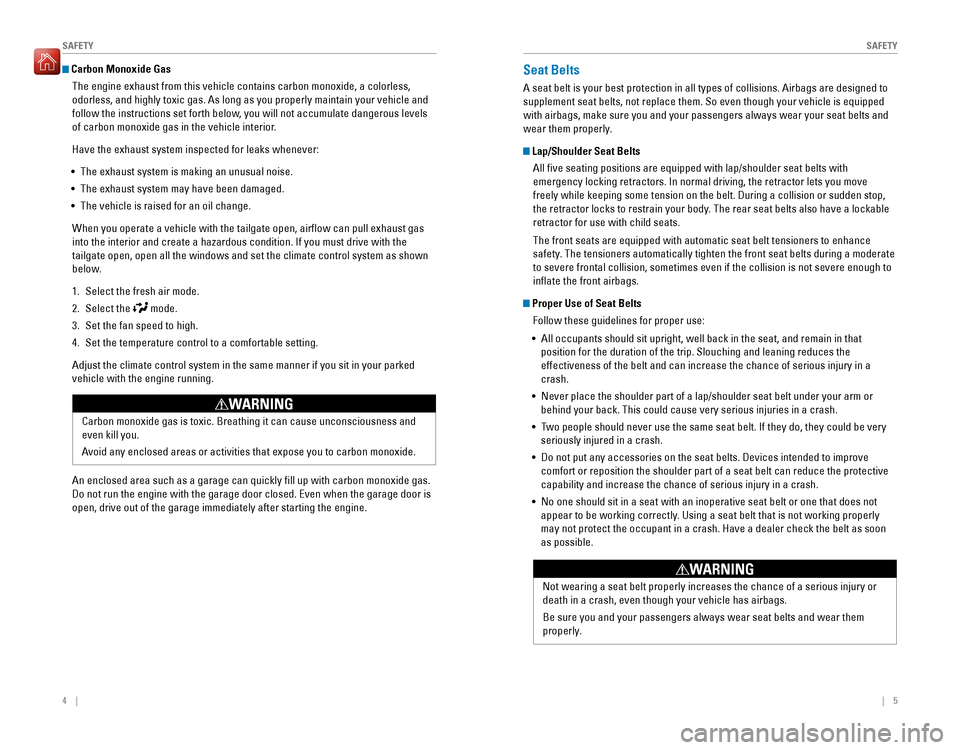
4 || 5
S
AFETY
SAFETY
Carbon Monoxide Gas
The engine exhaust from this vehicle contains carbon monoxide, a colorless,
odorless, and highly toxic gas. As long as you properly maintain your vehicle and
follow the instructions set forth below, you will not accumulate dangerous levels
of carbon monoxide gas in the vehicle interior. Have the exhaust system inspected for leaks whenever:
• The exhaust system is making an unusual noise.
• The exhaust system may have been damaged.
• The vehicle is raised for an oil change.
When you operate a vehicle with the tailgate open, air�ow can pull exhaust gas into the interior and create a hazardous condition. If you must drive with the
tailgate open, open all the windows and set the climate control system as shown
below.
1. Select the fresh air mode.
2. Select the
mode.
3. Set the fan speed to high. 4. Set the temperature control to a comfortable setting.
Adjust the climate control system in the same manner if you sit in your parked vehicle with the engine running.
Carbon monoxide gas is toxic. Breathing it can cause unconsciousness and even kill you.
Avoid any enclosed areas or activities that expose you to carbon monoxide.
WARNING
An enclosed area such as a garage can quickly ill up with carbon monoxide gas. Do not run the engine with the garage door closed. Even when the garage door is open, drive out of the garage immediately after starting the engine.
Seat Belts
A seat belt is your best protection in all types of collisions. Airbags are designed to supplement seat belts, not replace them. So even though your vehicle is equipped
with airbags, make sure you and your passengers always wear your seat belts and
wear them properly.
Lap/Shoulder Seat Belts
All ive seating positions are equipped with lap/shoulder seat belts with
emergency locking retractors. In normal driving, the retractor lets you move
freely while keeping some tension on the belt. During a collision or sudden stop,
the retractor locks to restrain your body. The rear seat belts also have a lockable retractor for use with child seats. The front seats are equipped with automatic seat belt tensioners to enhance
safety. The tensioners automatically tighten the front seat belts during a moderate
to severe frontal collision, sometimes even if the collision is not severe enough to inlate the front airbags.
Proper Use of Seat Belts
Follow these guidelines for proper use:
• All occupants should sit upright, well back in the seat, and remain in that
position for the duration of the trip. Slouching and leaning reduces the effectiveness of the belt and can increase the chance of serious injury in a crash.
• Never place the shoulder part of a lap/shoulder seat belt under your arm or
behind your back. This could cause very serious injuries in a crash.
• Two people should never use the same seat belt. If they do, they could be very seriously injured in a crash.
• Do not put any accessories on the seat belts. Devices intended to improve
comfort or reposition the shoulder part of a seat belt can reduce the protective capability and increase the chance of serious injury in a crash.
• No one should sit in a seat with an inoperative seat belt or one that does not appear to be working correctly. Using a seat belt that is not working properly may not protect the occupant in a crash. Have a dealer check the belt as soon as possible.
Not wearing a seat belt properly increases the chance of a serious injury or death in a crash, even though your vehicle has airbags. Be sure you and your passengers always wear seat belts and wear them
properly.
WARNING
Page 8 of 75
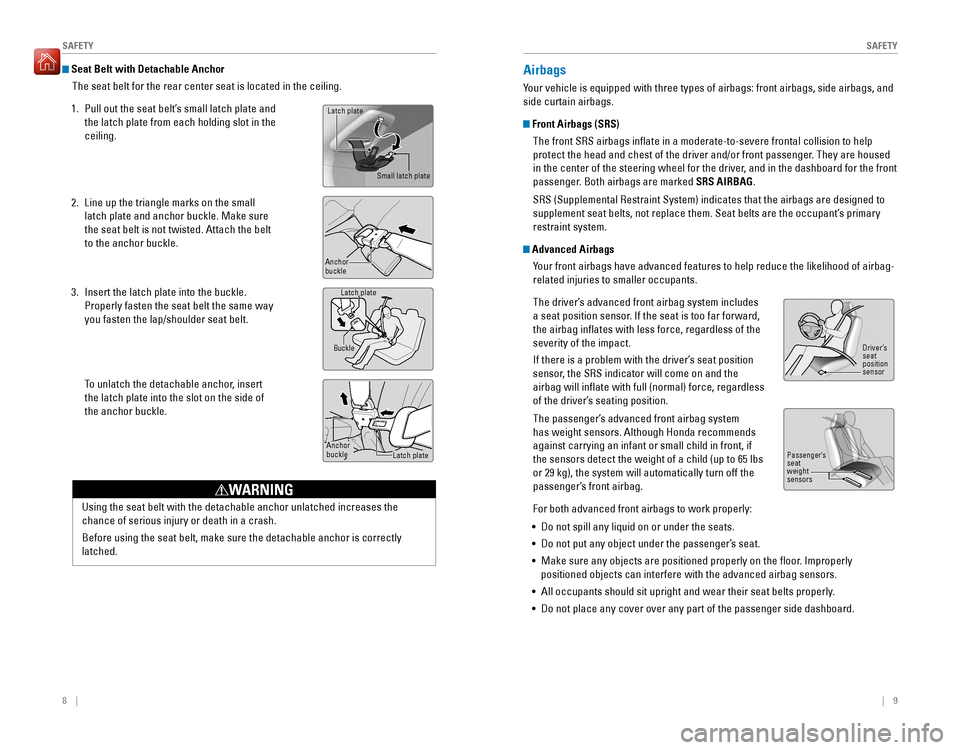
8 || 9
S
AFETY
SAFETY
Seat Belt with Detachable Anchor
The seat belt for the rear center seat is located in the ceiling.
1. Pull out the seat belt’s small latch plate and the latch plate from each holding slot in the ceiling.
2. Line up the triangle marks on the small latch plate and anchor buckle. Make sure the seat belt is not twisted. Attach the belt to the anchor buckle.
3. Insert the latch plate into the buckle. Properly fasten the seat belt the same way
you fasten the lap/shoulder seat belt.
To unlatch the detachable anchor, insert the latch plate into the slot on the side of the anchor buckle.
Using the seat belt with the detachable anchor unlatched increases the chance of serious injury or death in a crash. Before using the seat belt, make sure the detachable anchor is correctly latched.
WARNING
Airbags
Your vehicle is equipped with three types of airbags: front airbags, side airbags, and side curtain airbags.
Front Airbags (SRS)
The front SRS airbags inlate in a moderate-to-severe frontal collision to help
protect the head and chest of the driver and/or front passenger. They are housed
in the center of the steering wheel for the driver, and in the dashboard for the front
passenger. Both airbags are marked SRS AIRBAG.
SRS (Supplemental Restraint System) indicates that the airbags are designed to
supplement seat belts, not replace them. Seat belts are the occupant’s primary restraint system.
Advanced Airbags
Your front airbags have advanced features to help reduce the likelihood of airbag- related injuries to smaller occupants.
The driver’s advanced front airbag system includes
a seat position sensor. If the seat is too far forward, the airbag inlates with less force, regardless of the severity of the impact.
If there is a problem with the driver’s seat position
sensor, the SRS indicator will come on and the airbag will inlate with full (normal) force, regardless
of the driver’s seating position.
The passenger’s advanced front airbag system has weight sensors. Although Honda recommends against carrying an infant or small child in front, if the sensors detect the weight of a child (up to 65 lbs or 29 kg), the system will automatically turn off the
passenger’s front airbag. For both advanced front airbags to work properly:
• Do not spill any liquid on or under the seats.
• Do not put any object under the passenger’s seat.
• Make sure any objects are positioned properly on the loor. Improperly positioned objects can interfere with the advanced airbag sensors.
• All occupants should sit upright and wear their seat belts properly.
• Do not place any cover over any part of the passenger side dashboard.
Driver’s seat positionsensor
Passenger’s seatweightsensors
Latch plate
Anchor buckle
Latch plate
Buckle
Latch plate
Small latch plate
Anchor buckle
Page 10 of 75
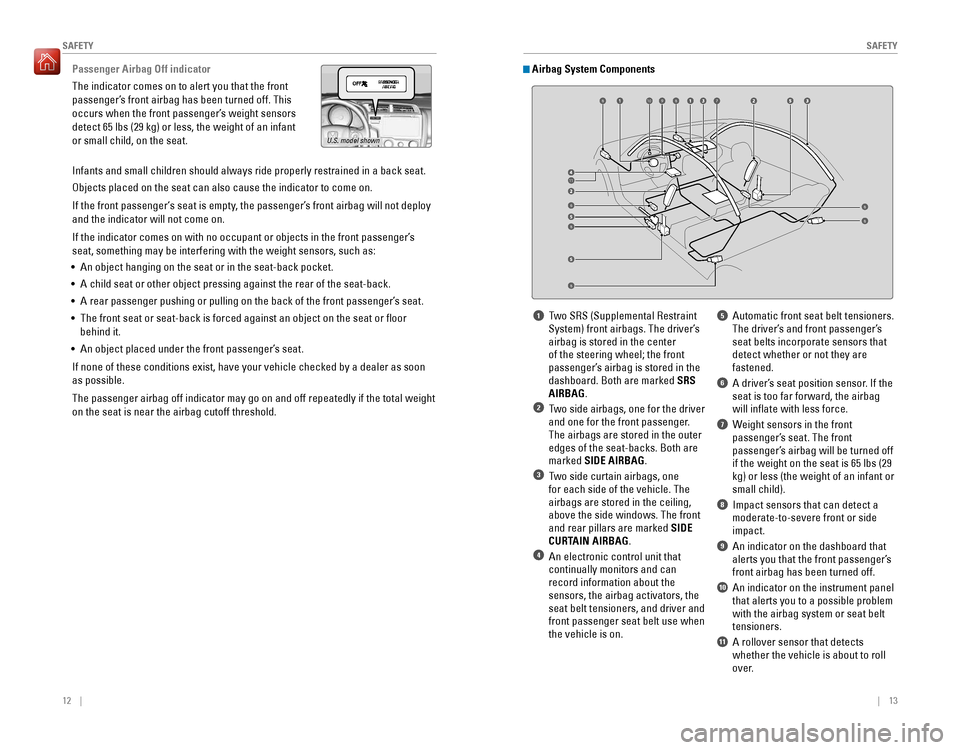
12 || 13
S
AFETY
SAFETY
Passenger Airbag Off indicator
The indicator comes on to alert you that the front
passenger’s front airbag has been turned off. This
occurs when the front passenger’s weight sensors detect 65 lbs (29 kg) or less, the weight of an infant or small child, on the seat.
Infants and small children should always ride properly restrained in a back seat. Objects placed on the seat can also cause the indicator to come on.
If the front passenger‘s seat is empty, the passenger’s front airbag will not deploy and the indicator will not come on.
If the indicator comes on with no occupant or objects in the front passenger’s seat, something may be interfering with the weight sensors, such as:
• An object hanging on the seat or in the seat-back pocket.
• A child seat or other object pressing against the rear of the seat-back.
• A rear passenger pushing or pulling on the back of the front passenger’s seat.
• The front seat or seat-back is forced against an object on the seat or loor behind it.
• An object placed under the front passenger’s seat.
If none of these conditions exist, have your vehicle checked by a dealer as soon as possible. The passenger airbag off indicator may go on and off repeatedly if the total weight on the seat is near the airbag cutoff threshold.
1 Two SRS (Supplemental Restraint System) front airbags. The driver’s airbag is stored in the center of the steering wheel; the front
passenger’s airbag is stored in the dashboard. Both are marked SRS
AIRBAG .
2 Two side airbags, one for the driver
and one for the front passenger. The airbags are stored in the outer edges of the seat-backs. Both are marked SIDE AIRBAG .
3 Two side curtain airbags, one
for each side of the vehicle. The airbags are stored in the ceiling, above the side windows. The front and rear pillars are marked SIDE
CURTAIN AIRBAG .
4 An electronic control unit that
continually monitors and can record information about the sensors, the airbag activators, the seat belt tensioners, and driver and front passenger seat belt use when the vehicle is on.
5 Automatic front seat belt tensioners. The driver’s and front passenger’s seat belts incorporate sensors that detect whether or not they are fastened.
6 A driver’s seat position sensor. If the seat is too far forward, the airbag will in�ate with less force.
7 Weight sensors in the front
passenger’s seat. The front
passenger’s airbag will be turned off if the weight on the seat is 65 lbs (29 kg) or less (the weight of an infant or small child).
8 Impact sensors that can detect a moderate-to-severe front or side impact.
9 An indicator on the dashboard that alerts you that the front passenger’s front airbag has been turned off.
10 An indicator on the instrument panel that alerts you to a possible problem with the airbag system or seat belt tensioners.
11 A rollover sensor that detects whether the vehicle is about to roll
over.
Airbag System Components
6
789
11
810
8
8
8
8
U.S. model shown
Page 11 of 75
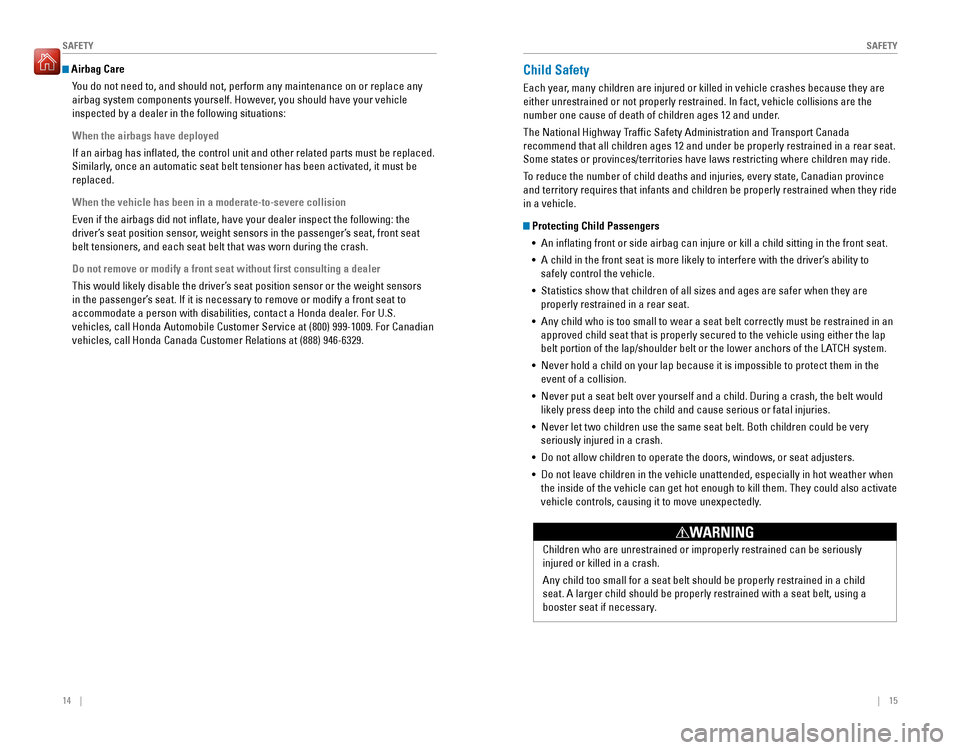
14 || 15
S
AFETY
SAFETY
Airbag Care
You do not need to, and should not, perform any maintenance on or replace any
airbag system components yourself. However, you should have your vehicle inspected by a dealer in the following situations:
When the airbags have deployed
If an airbag has inlated, the control unit and other related parts must be replaced.
Similarly, once an automatic seat belt tensioner has been activated, it must be replaced.
When the vehicle has been in a moderate-to-severe collision
Even if the airbags did not inlate, have your dealer inspect the following: the
driver’s seat position sensor, weight sensors in the passenger’s seat, front seat belt tensioners, and each seat belt that was worn during the crash.
Do not remove or modify a front seat without first consulting a dealer
This would likely disable the driver’s seat position sensor or the weight sensors
in the passenger’s seat. If it is necessary to remove or modify a front seat to
accommodate a person with disabilities, contact a Honda dealer. For U.S.
vehicles, call Honda Automobile Customer Service at (800) 999-1009. For Canadian vehicles, call Honda Canada Customer Relations at (888) 946-6329.
Child Safety
Each year, many children are injured or killed in vehicle crashes because they are either unrestrained or not properly restrained. In fact, vehicle collisions are the
number one cause of death of children ages 12 and under.
The National Highway Traf�c Safety Administration and Transport Canada recommend that all children ages 12 and under be properly restrained in a rear seat.
Some states or provinces/territories have laws restricting where children may ride.
To reduce the number of child deaths and injuries, every state, Canadian province and territory requires that infants and children be properly restrained when they ride in a vehicle.
Protecting Child Passengers
• An inlating front or side airbag can injure or kill a child sitting in the front seat.
• A child in the front seat is more likely to interfere with the driver’s ability to safely control the vehicle.
• Statistics show that children of all sizes and ages are safer when they are
properly restrained in a rear seat.
• Any child who is too small to wear a seat belt correctly must be restrained in an
approved child seat that is properly secured to the vehicle using either the lap
belt portion of the lap/shoulder belt or the lower anchors of the LATCH system.
• Never hold a child on your lap because it is impossible to protect them in the event of a collision.
• Never put a seat belt over yourself and a child. During a crash, the belt would
likely press deep into the child and cause serious or fatal injuries.
• Never let two children use the same seat belt. Both children could be very
seriously injured in a crash.
• Do not allow children to operate the doors, windows, or seat adjusters.
• Do not leave children in the vehicle unattended, especially in hot weather when the inside of the vehicle can get hot enough to kill them. They could also activate
vehicle controls, causing it to move unexpectedly.
Children who are unrestrained or improperly restrained can be seriously injured or killed in a crash. Any child too small for a seat belt should be properly restrained in a child
seat. A larger child should be properly restrained with a seat belt, using a
booster seat if necessary.
WARNING
Page 12 of 75
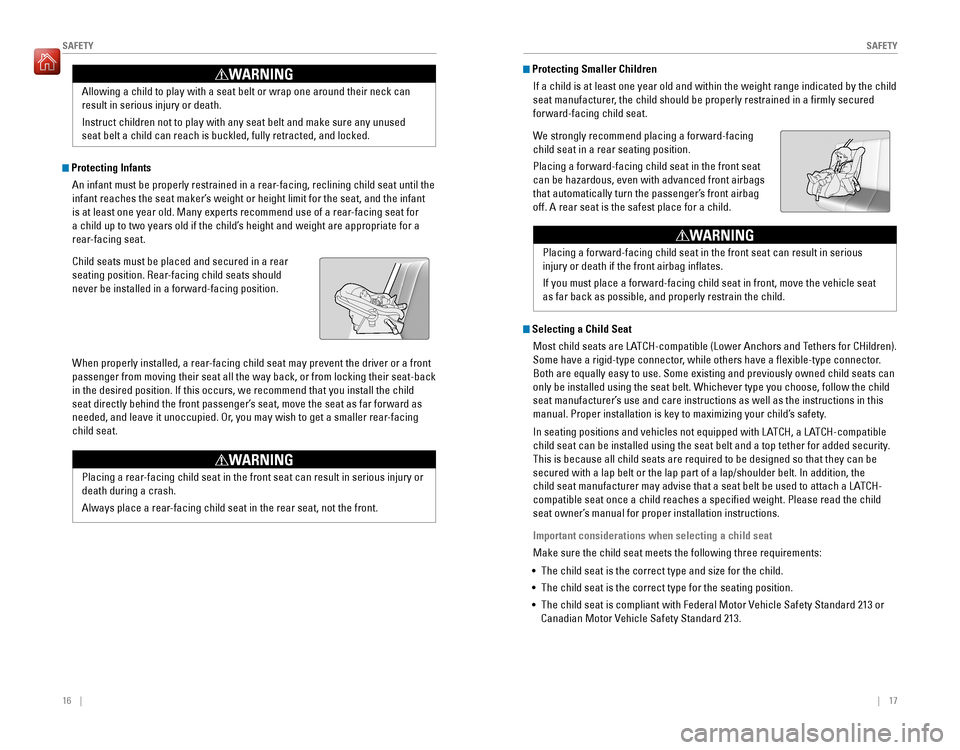
16 || 17
S
AFETY
SAFETY
Protecting Infants
An infant must be properly restrained in a rear-facing, reclining child seat until the
infant reaches the seat maker’s weight or height limit for the seat, and the infant
is at least one year old. Many experts recommend use of a rear-facing seat for
a child up to two years old if the child’s height and weight are appropriate for a
rear-facing seat. Child seats must be placed and secured in a rear
seating position. Rear-facing child seats should never be installed in a forward-facing position.
When properly installed, a rear-facing child seat may prevent the driver or a front
passenger from moving their seat all the way back, or from locking their seat-back in the desired position. If this occurs, we recommend that you install the child
seat directly behind the front passenger’s seat, move the seat as far forward as
needed, and leave it unoccupied. Or, you may wish to get a smaller rear-facing child seat.
Placing a rear-facing child seat in the front seat can result in serious injury or death during a crash.
Always place a rear-facing child seat in the rear seat, not the front.
WARNING
Allowing a child to play with a seat belt or wrap one around their neck can result in serious injury or death.
Instruct children not to play with any seat belt and make sure any unused seat belt a child can reach is buckled, fully retracted, and locked.
WARNING Protecting Smaller Children
If a child is at least one year old and within the weight range indicated by the child
seat manufacturer, the child should be properly restrained in a irmly secured forward-facing child seat.
We strongly recommend placing a forward-facing child seat in a rear seating position. Placing a forward-facing child seat in the front seat
can be hazardous, even with advanced front airbags
that automatically turn the passenger’s front airbag off. A rear seat is the safest place for a child.Placing a forward-facing child seat in the front seat can result in serious injury or death if the front airbag inlates.
If you must place a forward-facing child seat in front, move the vehicle seat as far back as possible, and properly restrain the child.
WARNING
Selecting a Child Seat
Most child seats are LATCH-compatible (Lower Anchors and Tethers for CHildren).
Some have a rigid-type connector, while others have a lexible-type connector.
Both are equally easy to use. Some existing and previously owned child seats can
only be installed using the seat belt. Whichever type you choose, follow the child
seat manufacturer’s use and care instructions as well as the instructions in this
manual. Proper installation is key to maximizing your child’s safety.
In seating positions and vehicles not equipped with LATCH, a LATCH-compatible
child seat can be installed using the seat belt and a top tether for added security. This is because all child seats are required to be designed so that they can be secured with a lap belt or the lap part of a lap/shoulder belt. In addition, the
child seat manufacturer may advise that a seat belt be used to attach a LATCH-compatible seat once a child reaches a speciied weight. Please read the child
seat owner’s manual for proper installation instructions.
Important considerations when selecting a child seat
Make sure the child seat meets the following three requirements:
• The child seat is the correct type and size for the child. • The child seat is the correct type for the seating position.
• The child seat is compliant with Federal Motor Vehicle Safety Standard 213 or
Canadian Motor Vehicle Safety Standard 213.
Page 13 of 75

18 || 19
S
AFETY
SAFETY
Installing a LATCH-Compatible Child Seat
A LATCH-compatible child seat can be installed in either of the two outer rear
seats. A child seat is attached to the lower anchors with either the rigid or lexible type of connectors.
1. Locate the lower anchors under the marks.
2. Raise the head restraint to its highest position.
3. Place the child seat on the vehicle seat, then attach the child seat to the lower anchors according to the instructions that came with the child seat. Make sure that the lower anchors are not obstructed by the seat belt or any other
object. If necessary, remove the cargo area
cover.*
4. Route the tether strap between the head restraint legs. Make sure the strap is not twisted. Secure
the tether strap hook onto the anchor.
5. Tighten the tether strap according to the seat manufacturer’s instructions.
6. Make sure the child seat is irmly secured by rocking it forward and back and side to side; little movement should be felt.
7. Make sure any unused seat belt that a child
can reach is buckled, the lockable retractor is activated, and the belt is fully retracted and
locked. If necessary, reinstall the cargo area
cover.*
Installing a Child Seat with a Lap/Shoulder Seat Belt
1. Raise the head restraint to its highest position.
2. Place the child seat on the vehicle seat.3. Route the seat belt through the child seat
according to the seat manufacturer’s instructions, and insert the latch plate into the buckle. Insert the latch plate fully until it clicks.
4. Slowly pull the shoulder part of the belt all the way out until it stops. This activates the lockable
retractor.
5. Let the seat belt completely wind up into the
retractor, then try to pull it out to make sure the retractor is locked. If you are able to pull the shoulder belt out, the lockable retractor is not activated. Pull the seat belt all the way out, and repeat steps 4 – 5.
6. Grab the shoulder part of the seat belt near the buckle, and pull up to remove any slack from the lap part of the belt. When doing this, place your weight on the child seat and push it into the vehicle seat.
7. Make sure the child seat is irmly secured by rocking it forward and back and side to side; little movement should be felt.
8. Make sure any unused seat belt that a child
can reach is buckled, the lockable retractor is activated, and the belt is fully retracted and locked.
To deactivate a lockable retractor, release the buckle and allow the seat belt to wind up all the way.
Marks
*if equipped (Canadian models)
Rigid type
Lower anchors
Flexible type
Anchor
Tether strap hook
Page 14 of 75
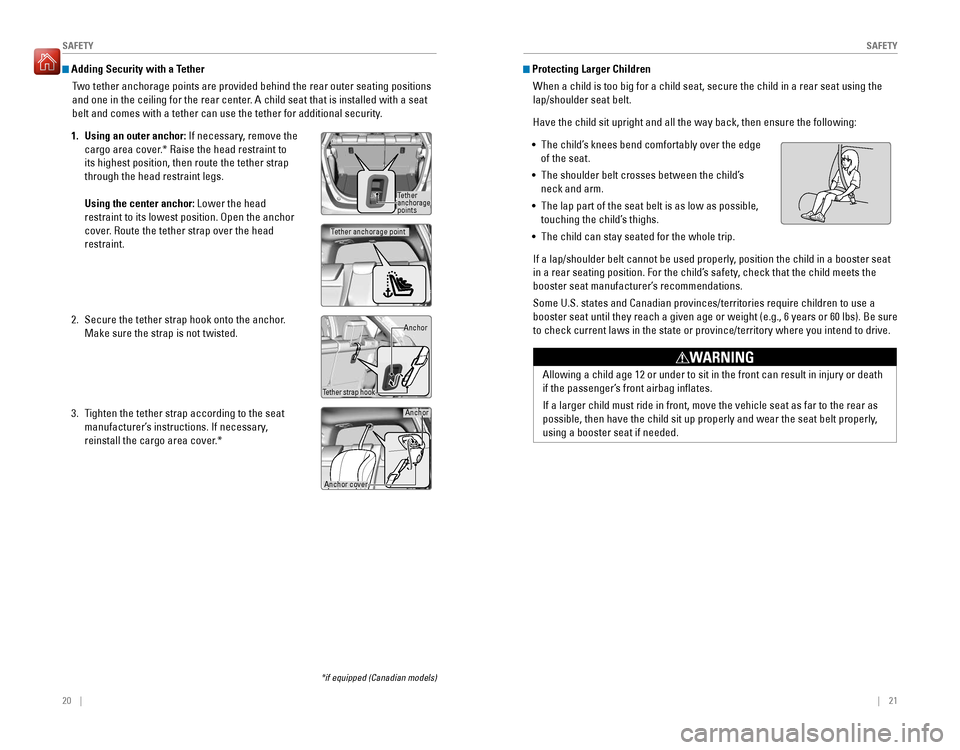
20 || 21
S
AFETY
SAFETY
Adding Security with a Tether
Two tether anchorage points are provided behind the rear outer seating positions
and one in the ceiling for the rear center. A child seat that is installed with a seat
belt and comes with a tether can use the tether for additional security.
1. Using an outer anchor: If necessary, remove the
cargo area cover.* Raise the head restraint to its highest position, then route the tether strap through the head restraint legs. Using the center anchor: Lower the head
restraint to its lowest position. Open the anchor
cover. Route the tether strap over the head restraint.
2. Secure the tether strap hook onto the anchor. Make sure the strap is not twisted.
3. Tighten the tether strap according to the seat manufacturer’s instructions. If necessary,
reinstall the cargo area cover.*
Protecting Larger Children
When a child is too big for a child seat, secure the child in a rear seat using the lap/shoulder seat belt. Have the child sit upright and all the way back, then ensure the following:
• The child’s knees bend comfortably over the edge of the seat.
• The shoulder belt crosses between the child’s
neck and arm.
• The lap part of the seat belt is as low as possible,
touching the child’s thighs.
• The child can stay seated for the whole trip.
If a lap/shoulder belt cannot be used properly, position the child in a booster seat
in a rear seating position. For the child’s safety, check that the child meets the
booster seat manufacturer’s recommendations. Some U.S. states and Canadian provinces/territories require children to use a
booster seat until they reach a given age or weight (e.g., 6 years or 60 lbs). Be sure to check current laws in the state or province/territory where you intend to drive.
Allowing a child age 12 or under to sit in the front can result in injury or death
if the passenger’s front airbag inlates.
If a larger child must ride in front, move the vehicle seat as far to the rear as possible, then have the child sit up properly and wear the seat belt properly, using a booster seat if needed.
WARNING
Tether
anchorage points
Tether strap hook Anchor
*if equipped (Canadian models)
Tether anchorage point
Anchor
Anchor cover
Page 74 of 75
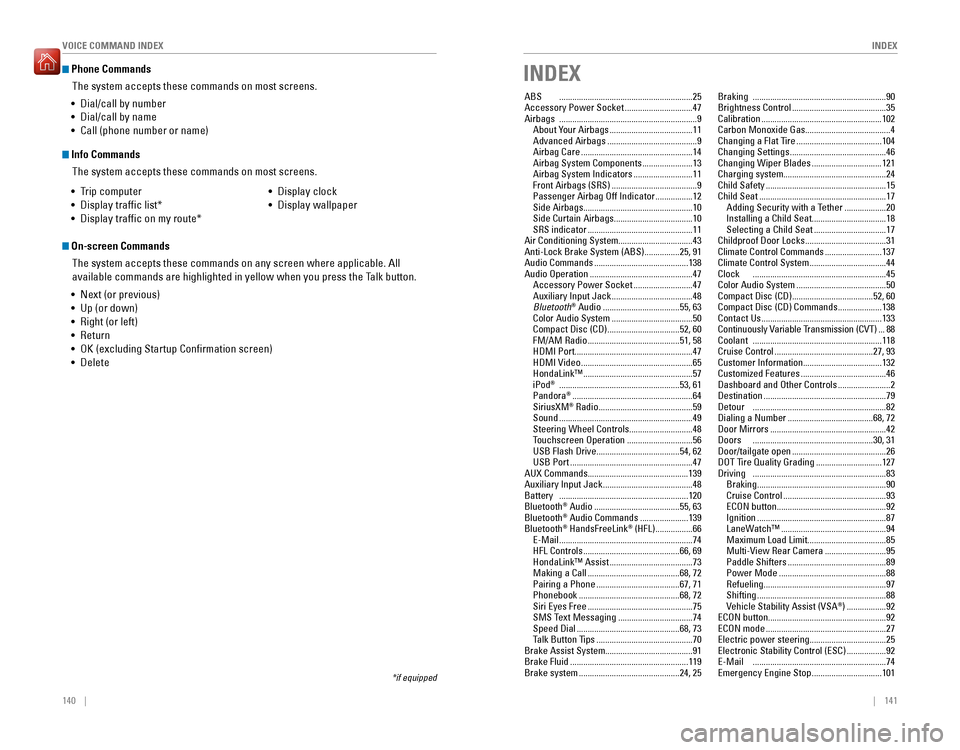
140 || 141
INDEX
VOICE COMMAND INDEX
Phone Commands
The system accepts these commands on most screens.
Info Commands
The system accepts these commands on most screens.
• Trip computer
• Display trafic list*
• Display trafic on my route* • Display clock
• Display wallpaper
On-screen Commands
The system accepts these commands on any screen where applicable. All
available commands are highlighted in yellow when you press the Talk button.
• Next (or previous)
• Up (or down)
• Right (or left)
• Return
• OK (excluding Startup Con�rmation screen)
• Delete
*if equipped
• Dial/call by number
• Dial/call by name
• Call (phone number or name)
INDEX
ABS
............................................................. 25
Accessory Power Socket ...............................47
Airbags ............................................................... 9
About Your Airbags ...................................... 11
Advanced Airbags ......................................... 9
Airbag Care ................................................... 14
Airbag System Components .......................13
Airbag System Indicators ...........................11
Front Airbags (SRS) ....................................... 9
Passenger Airbag Off Indicator .................12
Side Airbags .................................................. 10
Side Curtain Airbags ....................................10
SRS indicator ................................................ 11
Air Conditioning System..................................43 Anti-Lock Brake System (ABS) ................25, 91
Audio Commands ........................................... 138
Audio Operation ............................................... 47
Accessory Power Socket ...........................47
Auxiliary Input Jack ..................................... 48
Bluetooth ®
Audio ................................... 55, 63
Color Audio System ..................................... 50
Compact Disc (CD) .................................52, 60
FM/AM Radio .......................................... 51, 58
HDMI Port ...................................................... 47
HDMI Video ................................................... 65
HondaLink™ .................................................. 57
iPod ®
....................................................... 53, 61
Pandora ®
....................................................... 64
SiriusXM ®
Radio ........................................... 59
Sound ............................................................. 49
Steering Wheel Controls .............................48
Touchscreen Operation ..............................56
USB Flash Drive ...................................... 54, 62
USB Port ........................................................ 47
AUX Commands..............................................139Auxiliary Input Jack ......................................... 48
Battery ........................................................... 120
Bluetooth ®
Audio ....................................... 55, 63
Bluetooth ®
Audio Commands ......................139
Bluetooth ®
HandsFreeLink ®
(HFL) ................. 66
E-Mail ............................................................. 74
HFL Controls ............................................ 66, 69
HondaLink™ Assist ...................................... 73
Making a Call .......................................... 68, 72
Pairing a Phone ...................................... 67, 71
Phonebook .............................................. 68, 72
Siri Eyes Free ................................................ 75
SMS Text Messaging ..................................74
Speed Dial ............................................... 68, 73
Talk Button Tips ............................................ 70
Brake Assist System........................................91Brake Fluid ...................................................... 119
Brake system .............................................. 24, 25Braking
............................................................. 90
Brightness Control ........................................... 35
Calibration ....................................................... 102
Carbon Monoxide Gas .......................................4
Changing a Flat Tire ....................................... 104
Changing Settings ............................................ 46
Changing Wiper Blades ................................121
Charging system...............................................24Child Safety ....................................................... 15
Child Seat .......................................................... 17
Adding Security with a Tether ...................20
Installing a Child Seat ..................................18
Selecting a Child Seat .................................17
Childproof Door Locks .....................................31
Climate Control Commands ..........................137
Climate Control System ...................................44
Clock ............................................................. 45
Color Audio System ......................................... 50
Compact Disc (CD) ..................................... 52, 60
Compact Disc (CD) Commands ....................138
Contact Us ....................................................... 133
Continuously Variable Transmission (CVT) ...88
Coolant ........................................................... 118
Cruise Control ............................................. 27, 93
Customer Information ....................................132
Customized Features ....................................... 46
Dashboard and Other Controls ........................2
Destination ........................................................ 79
Detour ............................................................. 82
Dialing a Number ....................................... 68, 72
Door Mirrors ..................................................... 42
Doors ....................................................... 30, 31
Door/tailgate open ........................................... 26
DOT Tire Quality Grading ..............................127
Driving ............................................................. 83
Braking ........................................................... 90
Cruise Control ............................................... 93
ECON button .................................................. 92
Ignition ........................................................... 87
LaneWatch™ ................................................ 94
Maximum Load Limit ....................................85
Multi-View Rear Camera ............................95
Paddle Shifters ............................................. 89
Power Mode ................................................. 88
Refueling ........................................................ 97
Shifting ........................................................... 88
Vehicle Stability Assist (VSA ®
) .................. 92
ECON button ......................................................92
ECON mode ....................................................... 27
Electric power steering ...................................25
Electronic Stability Control (ESC) ..................92
E-Mail ............................................................. 74
Emergency Engine Stop ................................101